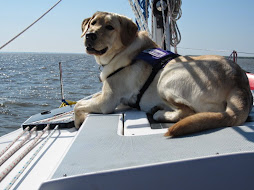A little while ago, we received an excellent question on Twitter from @mrlent about training dogs to alert for a fainting condition caused by heart rate. (See his original question here.) Our answer is going to take a few more characters than the 140 limit on Twitter, so we thought we would post it here.
Dogs have an amazing ability to respond to extremely subtle stimuli, sometimes so subtle that neither humans nor machines can pick up on them. It will seem like the dog is alerting to a condition. However, the dog is technically responding.
You may have heard of Diabetic Alert Dogs, and even though they have the word “alert” in their name, they are still responding to a stimulus, in this case an odor that the body produces when blood sugar drops. These dogs are trained to perform specific behaviors when they smell that particular odor.
Dogs that “alert” for seizures are also fairly well known. These dogs perform a behavior before a medical crisis arises, sometimes signaling their partner when a seizure is going to occur. However, these dogs are still responding to something, not alerting. We just aren’t sure what the dogs are responding to, which makes it seem like they’re alerting.
A dog could be trained to respond to a fainting condition. We have actually trained and placed several dogs with individuals whose primary disability involved fainting or loss of consciousness. A dog could easily be trained to retrieve a telephone, pull an emergency cord, cover the person with a blanket, dial 911, alert someone else in the house, etc. The only way a dog could be trained to alert to a condition would be if the person knows of specific things that usually occur before he or she loses consciousness. It is possible to train the dog to respond to these things, thereby creating an “alert” before the person faints.
Some of the dogs we have trained to respond to a fainting condition have developed alert behaviors. However, they are still technically responding to something – we as human just aren’t able to perceive what they are responding to. In order to train a dog to perform a behavior, we need to be able to perceive specific cues or stimuli.
Tuesday, November 17, 2009
Friday, November 6, 2009
Service Dogs: Specially Trained Partners
 In early September, we held our Meet the Dogs sessions where several people who had been on our waiting list got to meet the dog that would become their partner. Since then, we have been specially training each of those dogs for each person, so that when the service dog teams graduate, the dogs are able to assist their partners with their unique needs.
In early September, we held our Meet the Dogs sessions where several people who had been on our waiting list got to meet the dog that would become their partner. Since then, we have been specially training each of those dogs for each person, so that when the service dog teams graduate, the dogs are able to assist their partners with their unique needs.We’re dedicated to making sure that we are meeting the needs of each person who receives a service dog from us. When we’re matching people with a dog, we learn as much as we can about that person’s unique needs so we can specially train the dog. For example, one person may need to use the dog for balance as he moves. Because everyone gets around differently, we will fit a dog with a harness and have the person try using the dog as balance at our Meet the Dogs sessions. This gives the person the opportunity to find out how the dog will be able to assist him with balance. Also, because there are several different types of harnesses a balance dog can wear, this short demo allows the person and dog to find the type of harness that works best for them. From a training standpoint, it gives us the opportunity to observe how the person is walking or moving with the dog. In advanced training, we will then try to duplicate some of those movements so the dog is specially trained to do balance work with their partner.
Similarly, we sometimes need to change the name of a dog in order to meet a person’s needs. Each litter that we breed and raise is assigned a theme, and each puppy is named according to that theme. For example, our most recent litter is called the Crayon litter, and each puppy is named after a crayon color. However, when a person is matched with a dog, we may need to change the dog’s name for that person. For instance, we have placed several hearing dogs with people who are deaf or hard of hearing. Sometimes, because of their disability, the dog’s name may be difficult for the person to pronounce. We will then change the dog’s name for that person. Changing a dog’s name is not as difficult as it may seem. It is simply a matter of training the dog to respond to a different name. And something as simple as a name can mean all the difference to that dog’s human partner.
If you would like to read more about how we match people with dogs, please read our Meet the Dogs post.

Since 1994, 171 service dog teams have graduated from our program, and we currently have 26 puppies being raised by our wonderful, dedicated volunteers. As a fully accredited service dog organization, we are dedicated to high standards of quality and making sure that our service dogs are able to assist their partners with their unique needs. We love our work, and we’re looking forward to the day when the dogs that are currently in advanced training graduate with their new partners as working service dog teams.
Subscribe to:
Comments (Atom)








